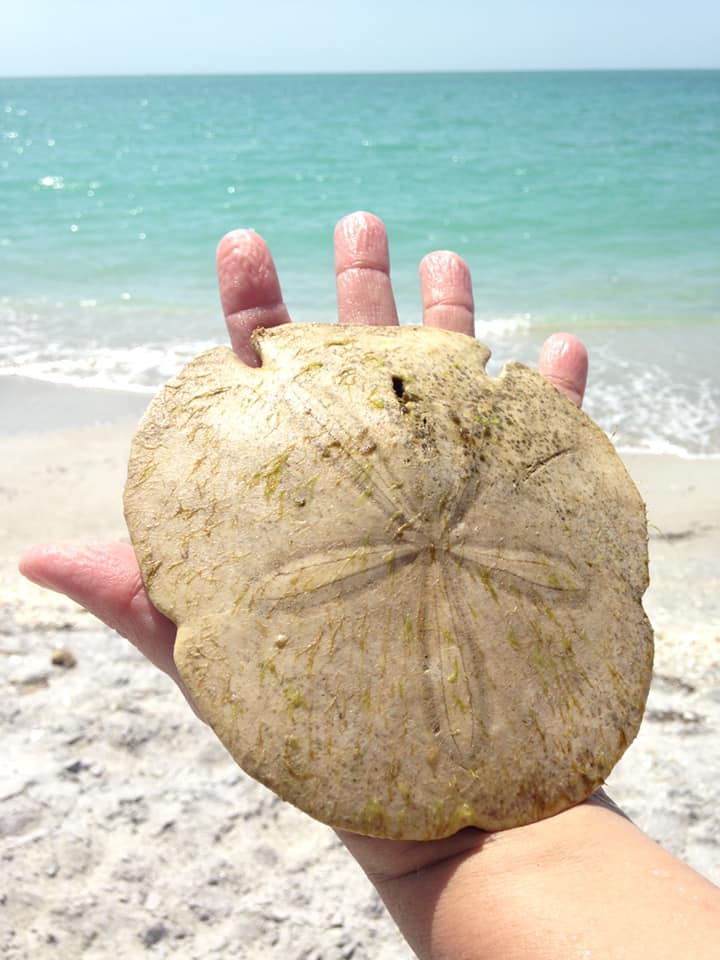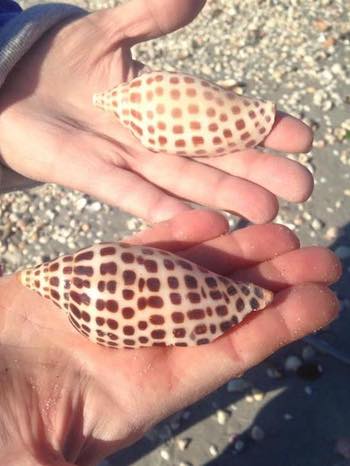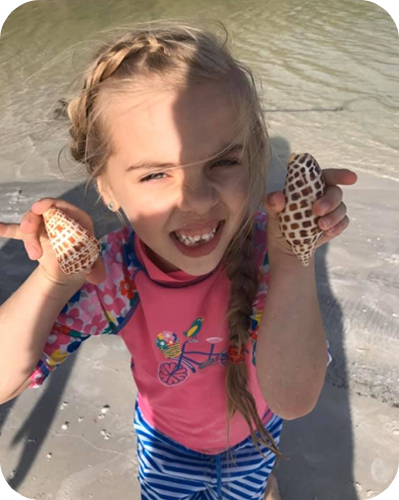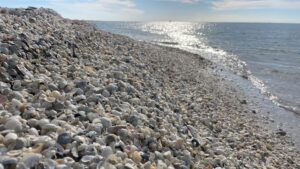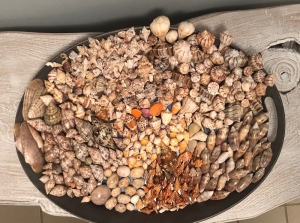Ever put a seashell up to your ear? Don’t the echoes sound like ocean waves, even when you’re miles away from the beach?
Truth is, those aren’t ghostly echoes of the ocean. Seashells have a unique shape that makes them amazing amplifiers for ambient noises, including air. The sound you hear is air passing through the shell, amplified to a great degree.
But that’s not the only cool thing about them. There are more seashell facts that make these mobile homes even more amazing.
Take a moment to consider these 15 cool facts about seashells:
-
Seashells are Mobile Homes
Table of Contents show
A seashell isn’t an animal. It’s a portable home for a wide variety of animals. The animals that naturally live in these homes are mollusks.
That said, not all mollusks use a shell. The cephalopod family, which includes the octopus and squid, don’t use a mobile home to keep them safe. Instead, they use other means of defense, like their ink or poisonous suction cups on their tentacles.
One thing that all mollusks have in common, whether they use a shell or not, is that they’re all invertebrates. This means they don’t have a rigid backbone. Most of the smaller mollusks, like clams or sea snails, use seashells as a means of defense against predators.
There is one special exception: hermit crabs also use seashells. However, they break the rules a bit. We’ll discuss them a bit more down below.
-
A Mollusk Has Only One Shell
Before tackling hermit crabs, let’s get one important fact out of the way: mollusks craft only one shell throughout their lifetime. They utilize a variety of proteins and calcium carbonate to create their exoskeleton. This becomes their home for the rest of their lives.
The cool thing about seashells is that they grow with the animal. As the mollusk gets older and bigger, so does the shell. It expands a little bit with each passing day, giving more space for the animal inside.
It’s important to note that very few animals keep their exoskeleton through all phases of their life. Most animals shed their exoskeletons as they get older. They then craft a newer, bigger one that better fits their size.
Mollusks, mentioned, stick with the one they started with.
BOOK YOUR SHELLING TOUR!
Are You Looking For A Guided Seashell Finding Tour in Southwest Florida? Book With Sand Dollar Shelling!
-
The Exception to Seashell Facts: Hermit Crabs
The only exceptions here are hermit crabs. They aren’t mollusks – they’re crustaceans. Despite this, they use seashells too.
However, they don’t craft their own shell. Instead, they wait for a mollusk to die and then they’ll occupy the empty shell. They’ll use a wide variety of seashell types too, as long as they fit in it and can carry the shell around with them.
This isn’t a new practice either. Hermit crabs existed for millions for years and they’ve always used other animal shells to shield them from predators. In fact, the oldest hermit crab using a shell (an ammonite shell) dates as far back as 130 million years ago.
-
Argonauts and Their Special Seashells
We mentioned above that cephalopods, like octopi and squids, are mollusks that don’t build a shell. There is one type of octopus, however, that didn’t evolve this way: the Argonaut.
Argonauts are the only known octopi that have a shell. However, they have the ability to leave their shell for a short period. Their shell features a unique design that lets the octopus inside bring it around while also reducing drag.
You can’t keep an Argonaut away from their shell for too long. Doing so will kill the animal.
Also, only female Argonauts create a shell. Unlike other seashell mollusks, they don’t secrete the shell-crafting chemicals from their mantles. They use their arms to build and repair the shell, thus guaranteeing each shell is always unique to the animal.
-
Shell Patterns and Colors Have Engineering Purposes
Aren’t seashells pretty? They often display a wide array of colors and unique patterns. However, it turns out those beautiful designs aren’t for display only.
Scientists believe that mollusks use these patterns and colors as engineering blueprints. The design lets the animal figure out where to place their mantle, ensuring they grow their shell in the right spots.
However, nobody knows what kind of pigment mollusks use to create these colors. It’s another fascinating mystery about these creatures and their seashells.
-
How Many Seashell Types are There?
Found a beautiful seashell while walking down the beach? Great, but how do you tell what kind of animal it was for?
Seashell identification is no easy task. Let’s get that little hurdle out of the way. This is because there are possibly over 200,000 mollusks in the world and all of them create unique types of shells.
Looking for a simple guide for the most common shell types? We’ve got one ready for you here.
-
Seashell Shapes are Important Too
While there are thousands of seashells, you can boil them down to two major types and two general shapes. Let’s discuss the shapes first.
The first common shape is a smooth, round design. This makes it easy for the animal to scoot around the ocean rather quickly. Mollusks that create these shells depend on stealth and speed to avoid predators lurking around them.
On the other hand, there are seashells riddled with spiky and uneven surfaces. These are more common in tropical waters since there are more predators in these areas. Mollusks with these seashells don’t move around too quickly; instead, they depend on their shell’s design to ward off predators.
They can use the sharp edges to hurt animals hunting them down. Some mollusks carry deadly poison in the pointy ends of their shells. Others rely on the thickness or heaviness of their shell to dissuade bigger creatures from attacking them.
Clams and oysters are a great example of the latter. Their shells are tightly shut, making it almost impossible for big fish to crack them open. Biting the shell isn’t effective either due to the shell’s durable nature.
-
Flat and Cone Seashell Types
As mentioned above, there are two general types of seashell types.
The first type is the flat shell. These are common for oysters and clams. More often than not, these are bivalve shells.
A bivalve shell has two halves that open and closes, held together at the hinge by a powerful ligament. The animal rests inside this enclosure. Clams that bear pearls use bivalve shells.
Cone types are the other general shape. This is what you’ll find when looking at sea snails, the Nautilus, or Argonaut. Their shell shape makes it hard for predators to swallow them whole and these animals are often poisonous too.
-
They Open to the Right
Did you know the vast majority of shells are dextral? This means their opening is to the right. Only a select few shells are sinistral, meaning they open to the left.
Shell collectors love sinistral shells because of their rarity. If you ever happen to come across sinistral shells, don’t pass up the chance to grab it! Beware, however, because there are now a lot of fake sinistral shells on the market too.
That said, animals with sinistral shells have a difficult time reproducing. They can’t mate with their dextral counterparts. Instead, they have to go through the extra effort of scouring the vast ocean for another sinistral.
This mating complication may explain why sinistrals are rare.
-
People Used Seashells as Currency
Money is a universal need, even in the earliest days of human history. When the days of bartering were over, trade utilized rare and precious metals like gold or silver as currency. However, cowry shells were also a lucrative form of money as well.
Cowry shells functioned as currency in places like China, India, and even in the Arabian peninsula. To this day, you can use cowry shells as money in Papua New Guinea. However, they only use it now as a form of a nostalgic artifact, like a means of honoring their ancient customs.
Shells were great forms of money for two reasons: uniform shells of high quality were hard to come by and these shells were durable. More often than not, only the rich and well-established nobles could use seashells as money on a regular basis.
-
People Love Seashells
It’s no secret that nearly every beach has a store selling seashells. Seashells make for great souvenirs. You’ll find them used as earrings, necklace pendants, or even wallet adornments.
The amazing fact is that this isn’t a new practice. In fact, the hobby of collecting seashells may be as old as human history.
The oldest known seashell collection dates back to 74 AD in Pompeii. Some of the shells in the collection originated in distant waters, some coming from the Red Sea. It appeared as if the collector gathered these seashells for no other reason than the fact they were beautiful.
People continue to do so today. Why don’t you consider going on a shelling tour and start your own seashell collection? It might be a lucrative hobby to remind you of the different places you’ve been to.
-
Seashells as Instruments
Remember a while back we mentioned how seashells are great for amplifying ambient sounds? This same property makes them ideal wind instruments. Many places across the world, such as Japan and the Caribbean, use seashells for musical purposes.
Perhaps the most popular instrument made from seashells is the conch. People also refer to it as a seashell horn. There are other instruments to try out, like seashell flutes from Japan or seashell ocarinas.
There are indications that the first musical instruments may be seashells fashioned to blow musical notes. However, there are no concrete pieces of evidence to prove this theory. As of today, the oldest known instruments came from bones, fashioned into early forms of flutes.
-
The Shell Beach
Looking for the ultimate shell destination? There’s a beach that stretches over 74 feet and goes as far down as 32 feet, located in Western Australia. Known as Shell Beach, this place is popular because shells fill up that whole stretch.
There are smaller “shell beaches” around the world but the one in Australia is the most prominent. You can find thousands of different shells there, both broken and still whole.
Other places with shell beaches include Sulu in the Philippines, Sanibel Island in Florida, and Jeffreys Bay in South Africa. These are all great destinations for people who love to collect seashells. They’re also beautiful beaches with clear water, making them fantastic tourist destinations.
-
Seashells Make Great Fertilizers
Remember we said mollusks make their shells out of calcium carbonate? This very property also makes shells an amazing ingredient for effective fertilizers.
Calcium carbonate helps maintain the pH levels in the soil and they help cut down the toxicity in the soil. They also make it easier for plants to absorb other important nutrients in the soil. Of course, they also provide calcium which is important for better plant growth.
You also don’t have to worry about harmful chemicals. Using seashells as fertilizers are great for people trying to maintain an organic farm.
-
Oldest Human Art
Think seashell art is a new thing? Think again!
We’ve used seashells to express our artistic side for thousands of years. As a matter of fact, newer discoveries hint that Homo Sapiens were not the first ones to convey a sense of art on a wall or shell.
A discovery in Indonesia focuses on a clamshell dating some 430,000 to 540,000 years ago.
The amazing fact is that there are clear signs of “art” on the shell’s surface. Even more amazing is that it wasn’t a Homo Sapien responsible for the art; instead, scientists point out the art was by a member of the Homo Erectus species. Homo Erectus is an ancient ancestor to modern humans and this discovery hints that even ancient ancestors had some level of intelligence to convey art.
Start Your Seashell Collection Today!
We hope these seashell facts made you fall in love with these amazing little mobile homes. There are so many types and their history go hand-in-hand with that of the Earth, spanning hundreds of thousands of years!
But why settle looking at pictures of seashells when you can start your own collection?
We’ve got the perfect opportunity for you. Contact us today by calling Sand Dollar Shelling 239-301-8913 and we can help you book a seashell tour, guaranteeing you get to visit the right locations and find as many amazing shells as possible!

